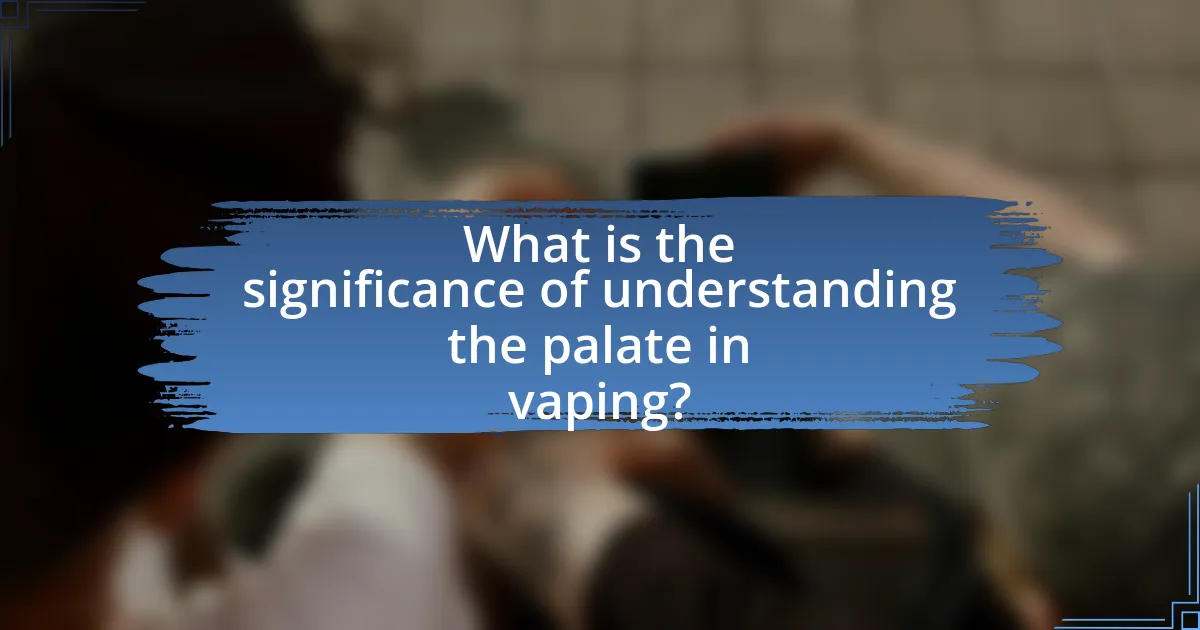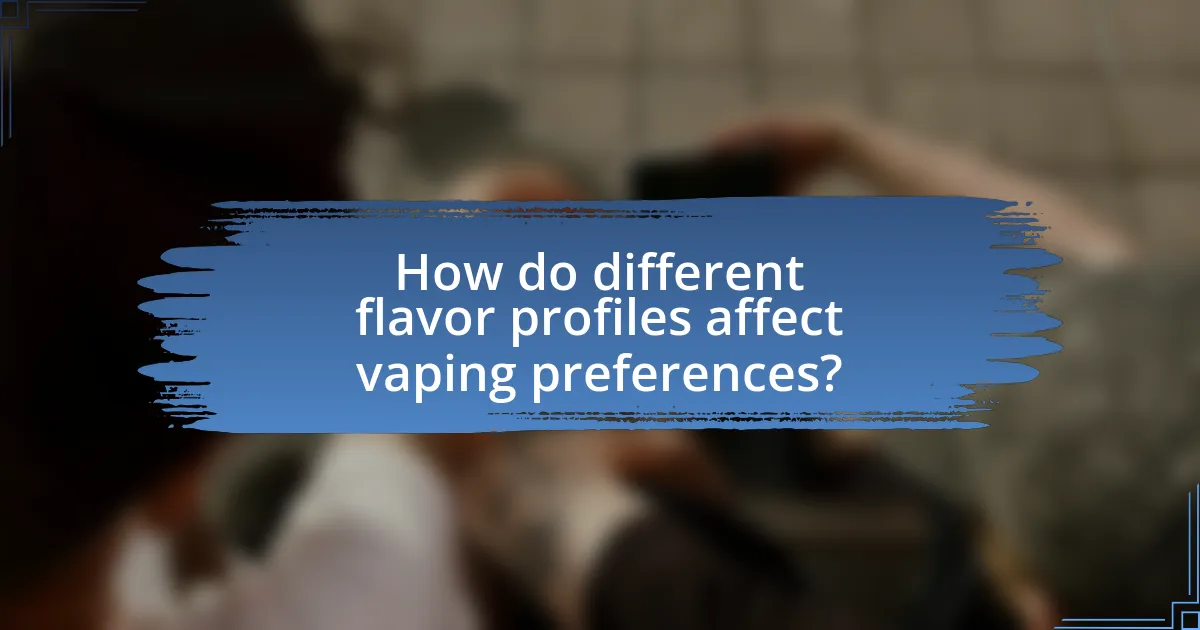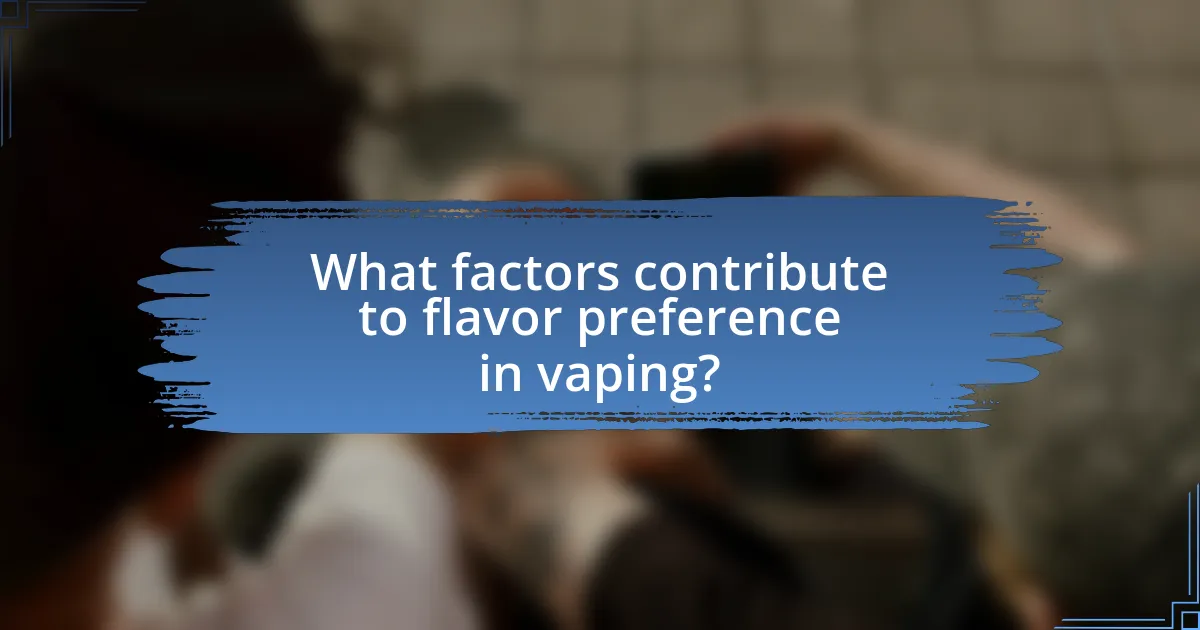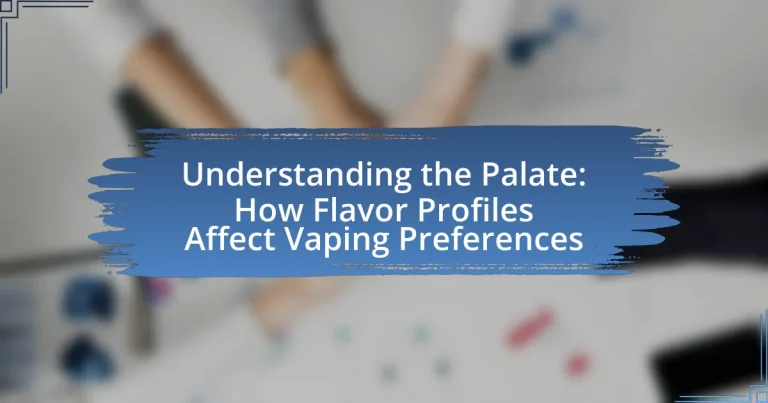The article focuses on the significance of understanding the palate in vaping, emphasizing how individual taste perception influences flavor preferences and overall user satisfaction. It explores the impact of flavor profiles on vaping experiences, highlighting popular categories such as fruit, dessert, menthol, and tobacco. Additionally, the article examines factors that shape flavor choices, including genetic predispositions, cultural influences, and psychological aspects like mood and social dynamics. By analyzing these elements, the article aims to provide insights into how flavor variety and complexity affect vaping habits and preferences, ultimately enhancing user engagement in the vaping market.

What is the significance of understanding the palate in vaping?
Understanding the palate in vaping is significant because it directly influences user satisfaction and preference for specific flavors. The palate refers to an individual’s taste perception, which affects how flavors are experienced when vaping. Research indicates that flavor preferences can vary widely among users, impacting their overall vaping experience and likelihood of continued use. For instance, a study published in the journal Tobacco Control found that flavor variety plays a crucial role in attracting new users to vaping, particularly among younger demographics. This highlights the importance of understanding the palate to cater to diverse tastes and enhance user engagement in the vaping market.
How do flavor profiles influence vaping experiences?
Flavor profiles significantly influence vaping experiences by affecting user satisfaction and preference. Different flavors can evoke specific emotions and memories, enhancing the overall enjoyment of vaping. For instance, studies indicate that fruity and dessert flavors are among the most popular choices, as they provide a sweeter and more enjoyable experience compared to traditional tobacco flavors. Additionally, flavor variety can cater to individual tastes, leading to increased usage frequency and brand loyalty among vapers. Research shows that 70% of vapers prefer flavored e-liquids, highlighting the critical role flavor profiles play in shaping vaping habits and preferences.
What are the primary flavor categories in vaping?
The primary flavor categories in vaping are fruit, dessert, menthol, tobacco, and beverage. These categories encompass a wide range of specific flavors that appeal to different preferences among vapers. For instance, fruit flavors often include options like strawberry and mango, while dessert flavors can range from vanilla custard to chocolate cake. Menthol flavors provide a cooling sensation, tobacco flavors mimic traditional cigarette tastes, and beverage flavors can include coffee or soda. This classification helps vapers select e-liquids that align with their taste preferences, enhancing their overall vaping experience.
How do individual taste preferences shape flavor choices?
Individual taste preferences significantly shape flavor choices by influencing the selection of flavors that resonate with personal likes and dislikes. These preferences are often formed through a combination of genetic factors, cultural background, and past experiences with food and beverages. For instance, research indicates that genetic variations can affect taste receptor sensitivity, leading individuals to prefer sweet, salty, or bitter flavors differently. Additionally, cultural influences can dictate which flavors are commonly accepted or sought after, as seen in regional cuisines that favor specific flavor profiles. This interplay of genetics and culture ultimately guides consumers in their flavor choices, particularly in niche markets like vaping, where flavor variety is extensive and personal preference plays a crucial role in product selection.
Why is palate awareness important for vapers?
Palate awareness is important for vapers because it enhances the ability to identify and appreciate different flavor profiles in e-liquids. This awareness allows vapers to make informed choices about their vaping experience, leading to greater satisfaction and enjoyment. Research indicates that flavor perception is closely linked to individual preferences, and understanding one’s palate can help vapers select flavors that align with their tastes, ultimately improving their overall vaping experience.
How does palate sensitivity affect flavor perception?
Palate sensitivity significantly influences flavor perception by determining how individuals detect and interpret different taste components. Individuals with heightened palate sensitivity are more adept at identifying subtle flavors and nuances in food and beverages, which can enhance their overall tasting experience. Research indicates that variations in taste receptor genes can lead to differences in sensitivity; for example, people with a higher number of taste buds may experience flavors more intensely. This heightened sensitivity can affect preferences, as those with a sensitive palate may favor complex flavor profiles, while those with lower sensitivity might prefer simpler, more pronounced tastes.
What role does cultural background play in flavor preferences?
Cultural background significantly influences flavor preferences by shaping individuals’ taste experiences and food choices. Different cultures have distinct culinary traditions, which include specific flavor profiles that are commonly enjoyed, such as sweetness in Asian cuisines or spiciness in Latin American dishes. Research indicates that these cultural influences can lead to varying preferences for flavors in products like vaping liquids, where individuals may gravitate towards flavors that reflect their cultural heritage. For example, a study published in the journal “Appetite” by authors A. Drewnowski and C. Almiron-Roig found that cultural exposure affects taste perception and preference, demonstrating that individuals from different backgrounds may prefer different flavor combinations based on their cultural experiences.

How do different flavor profiles affect vaping preferences?
Different flavor profiles significantly influence vaping preferences by catering to individual taste preferences and enhancing the overall vaping experience. Research indicates that users often gravitate towards specific flavors that evoke positive emotions or memories, such as fruity or dessert flavors, which can lead to increased satisfaction and prolonged usage. A study published in the journal Tobacco Control found that 70% of vapers preferred sweet flavors, highlighting the strong correlation between flavor choice and user enjoyment. Additionally, flavor variety can attract new users to vaping, as diverse options appeal to a broader audience, thereby impacting market trends and product development in the vaping industry.
What are the most popular flavor profiles among vapers?
The most popular flavor profiles among vapers include fruit, dessert, menthol, and tobacco. Fruit flavors, such as strawberry and watermelon, dominate the market due to their refreshing and sweet profiles, appealing to a wide range of users. Dessert flavors, like vanilla custard and chocolate, attract those seeking a rich and indulgent experience. Menthol flavors provide a cooling sensation, often preferred by users transitioning from traditional cigarettes. Tobacco flavors cater to former smokers looking for a familiar taste. According to a survey by the American Vaping Association, over 60% of vapers reported fruit flavors as their top choice, highlighting their popularity in the vaping community.
How do fruity flavors compare to dessert flavors in popularity?
Fruity flavors are generally more popular than dessert flavors in the vaping market. According to a survey conducted by the National Institute on Drug Abuse, fruity flavors accounted for approximately 60% of the vaping market share, while dessert flavors represented around 30%. This trend indicates a strong preference among consumers for fruity profiles, likely due to their refreshing taste and appeal to a broader audience, including younger users.
What unique characteristics do menthol and tobacco flavors offer?
Menthol and tobacco flavors offer distinct characteristics that cater to different sensory experiences in vaping. Menthol provides a cooling sensation and a refreshing taste, which can enhance the overall vaping experience by reducing throat irritation and adding a layer of complexity to the flavor profile. Tobacco flavors, on the other hand, deliver a rich, earthy taste that mimics traditional smoking, appealing to users seeking a familiar experience. Research indicates that menthol can also mask the harshness of nicotine, making it more palatable for new users, while tobacco flavors often evoke nostalgia for former smokers, reinforcing their preference for these flavors in vaping products.
How do flavor combinations impact vaping satisfaction?
Flavor combinations significantly impact vaping satisfaction by enhancing the overall sensory experience and influencing user preferences. When vapers encounter well-balanced and complementary flavors, they often report higher levels of enjoyment and satisfaction. Research indicates that specific combinations, such as fruit and menthol or dessert and cream, can create a more complex and appealing taste profile, which leads to increased user engagement and prolonged usage. A study published in the journal “Tobacco Control” found that flavor variety and complexity are key factors in user satisfaction, with 70% of participants indicating that flavor combinations directly influenced their likelihood to continue vaping.
What are the benefits of complex flavor blends?
Complex flavor blends enhance the overall vaping experience by providing a richer and more satisfying taste profile. These blends often combine multiple flavor notes, which can create depth and complexity that single-note flavors lack. Research indicates that consumers are more likely to enjoy and prefer products with intricate flavor combinations, as they stimulate the palate and can evoke a wider range of sensory responses. For instance, a study published in the journal “Food Quality and Preference” found that participants rated complex flavor profiles higher in terms of overall enjoyment compared to simpler flavors, demonstrating the appeal of multifaceted taste experiences.
How do vapers perceive sweetness in e-liquids?
Vapers perceive sweetness in e-liquids primarily through the presence of sweeteners and flavoring agents, which enhance the overall taste experience. Research indicates that common sweeteners used in e-liquids, such as sucralose and ethyl maltol, can significantly influence the perception of sweetness, making the vaping experience more enjoyable. A study published in the journal “Tobacco Control” by Farsalinos et al. (2015) found that the addition of sweeteners can lead to a more favorable evaluation of flavors among vapers, suggesting that sweetness plays a crucial role in flavor preference and satisfaction.

What factors contribute to flavor preference in vaping?
Flavor preference in vaping is influenced by several factors, including individual taste perception, nicotine content, and the quality of flavoring agents used. Individual taste perception varies due to genetic differences, which affect how flavors are experienced; for instance, some people may be more sensitive to sweetness or bitterness. Nicotine content can also impact flavor preference, as higher nicotine levels may enhance or alter the perception of certain flavors. Additionally, the quality of flavoring agents plays a crucial role; high-quality, food-grade flavorings tend to produce more satisfying and complex flavors, leading to greater user satisfaction. Research indicates that these factors collectively shape the overall vaping experience and influence consumer choices in flavor selection.
How does nicotine strength influence flavor perception?
Nicotine strength significantly influences flavor perception by altering the overall sensory experience of vaping. Higher nicotine concentrations can enhance throat hit and intensity, which may overshadow or complement specific flavor notes. Research indicates that nicotine can interact with taste receptors, potentially modifying the perception of sweetness and bitterness in e-liquids. For instance, a study published in the journal “Tobacco Control” found that higher nicotine levels can lead to a more pronounced perception of certain flavors, affecting user preferences and satisfaction.
What is the relationship between nicotine and flavor intensity?
Nicotine influences flavor intensity in vaping products by enhancing the perception of flavors. Research indicates that nicotine can amplify the sensory experience, making flavors seem more pronounced. For instance, a study published in the journal “Chemical Senses” found that nicotine interacts with taste receptors, potentially increasing the overall flavor experience for users. This relationship suggests that higher nicotine concentrations may lead to a more intense flavor perception, impacting consumer preferences in vaping.
How do different vaping devices affect flavor delivery?
Different vaping devices significantly affect flavor delivery due to variations in design, heating methods, and airflow. For instance, devices like sub-ohm tanks produce larger vapor clouds and enhance flavor intensity by utilizing lower resistance coils that heat e-liquid more efficiently. Conversely, pod systems often deliver a more muted flavor experience because they typically use higher resistance coils and smaller airflow, which can limit vapor production and flavor concentration. Research indicates that the temperature at which e-liquids are vaporized also plays a crucial role; higher temperatures can enhance flavor compounds but may also lead to burnt tastes if not managed properly. Thus, the choice of vaping device directly influences the richness and clarity of flavor experienced by the user.
What psychological factors influence flavor choices in vaping?
Psychological factors influencing flavor choices in vaping include personal preferences, social influences, and emotional associations. Personal preferences are shaped by individual taste experiences and past exposure to certain flavors, which can lead to a strong inclination towards familiar or nostalgic options. Social influences, such as peer recommendations and trends within vaping communities, significantly impact flavor selection, as individuals often seek flavors that are popular or endorsed by their social circles. Emotional associations also play a crucial role; flavors that evoke positive memories or feelings can enhance the vaping experience, making users more likely to choose those flavors. Research indicates that flavor preferences are not only a matter of taste but are deeply intertwined with psychological and social contexts, highlighting the complexity of consumer behavior in vaping.
How does mood affect flavor preference during vaping?
Mood significantly influences flavor preference during vaping, as emotional states can alter sensory perception and cravings. Research indicates that positive moods often lead to a preference for sweeter and more complex flavors, while negative moods may drive individuals toward more intense or bitter flavors. For instance, a study published in the journal “Appetite” by authors such as K. A. van Strien found that individuals experiencing stress or sadness tend to gravitate towards flavors that provide comfort, often favoring richer or nostalgic tastes. This connection between mood and flavor preference highlights the psychological aspects of vaping, where emotional states can dictate the choice of e-liquid flavors.
What role does social influence play in flavor selection?
Social influence significantly impacts flavor selection by shaping individual preferences through social norms, peer recommendations, and cultural trends. Research indicates that consumers often choose flavors that are popular within their social circles or that align with prevailing trends, as seen in studies showing that individuals are more likely to select flavors endorsed by friends or influencers. For instance, a study published in the Journal of Consumer Research found that social interactions can lead to a preference for specific flavors, demonstrating that social validation plays a crucial role in decision-making processes related to flavor choices.
What are some tips for choosing the right flavor profile for vaping?
To choose the right flavor profile for vaping, consider your personal taste preferences and the type of experience you seek. Start by identifying flavors you enjoy in food and beverages, as these can translate well into vaping. For example, if you prefer fruity flavors, explore options like strawberry or mango, which are popular among vapers. Additionally, consider the nicotine strength and the type of device you use, as these factors can influence the flavor intensity. Research indicates that flavor variety can enhance user satisfaction, with a study showing that 70% of vapers prefer sweet or dessert flavors, highlighting the importance of aligning your choice with popular preferences.


